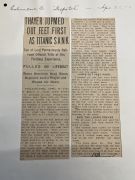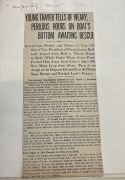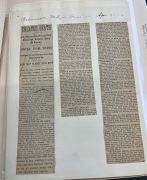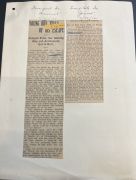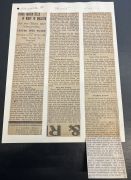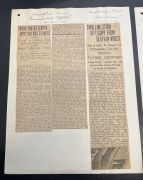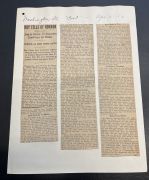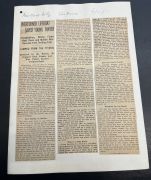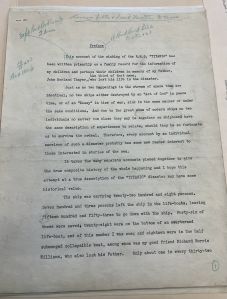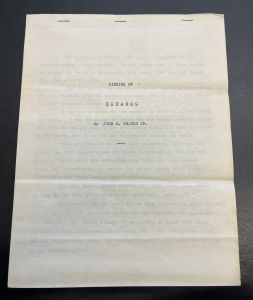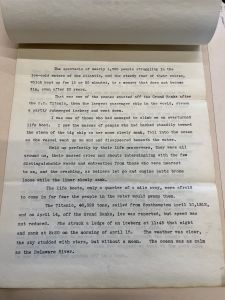John B. Thayer Titanic Memorial Collection
The John B. Thayer Memorial Collection of the sinking of the Titanic was started in memory of John Borland Thayer Sr. who died in 1912 during the sinking of the ocean liner’s maiden voyage.
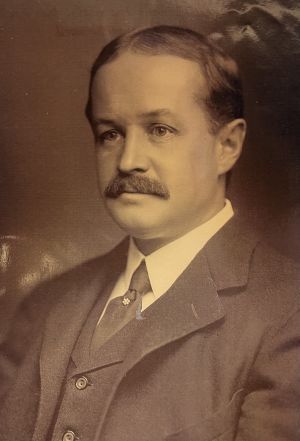
Thayer’s wife, Marian Longstreth Morris Thayer, and son, John B. “Jack” Thayer, survived the tragedy; the latter began the collection by providing testimony of the incident to various news outlets and saving many clippings of said testimony. The collection, started by Jack Thayer in 1912 and continued by his descendants until 2014, is largely made up of ephemera including, but not limited to: a copyright certificate, a funeral program for Thayer Sr., photographs of the Thayer family, newspaper clippings (documenting Thayer’s survivor’s testimony, the construction of Titanic memorials, the discovery and display of recovered artifacts from the sunken ship, and the deaths of Titanic survivors through the years) and letters of solicitation from important re-tellers of Titanic’s history, such as the Titanic Historical Society, Captain Richard Fremont-Smith (Thayer’s cousin and facilitator of the republication of Thayer’s memoir), and the production office of James Cameron’s 1997 film Titanic.
History

I want to focus my writing on the function of the collection as a historical body that showcases the progression of social and cultural memory of trauma as it relates to the Titanic tragedy. I think the collection is historically significant as the Thayer family’s efforts to memorialize their patriarch, recount their trauma and keep the Thayer legacy alive change over time.

Beginning with news clipping of Jack’s individual oral history as a Titanic survivor, the collection grows, as times passes, and manifests more official and authoritative efforts to memorialize the tragedy, including Jack’s privately published memoir, the public re-publishing of the same memoir by his cousin, and documentation of James Cameron’s efforts to authenticate his film by consulting Thayer family records. The John B. Thayer memorial collection of the sinking of the Titanic was started in memory of John Borland Thayer Sr. who died in 1912 during the sinking of the ocean liner’s maiden voyage. Thayer’s wife, Marian Longstreth Morris Thayesr, and son, John B. “Jack” Thayer, survived the tragedy; the latter began the collection by providing testimony of the incident to various news outlets and saving many clippings of said testimony.
The collection, started by Jack Thayer in 1912 and continued by his descendants until 2014, is largely made up of ephemera including, but not limited to: a copyright certificate, a funeral program for Thayer Sr., photographs of the Thayer family, newspaper clippings (documenting Thayer’s survivor’s testimony, the construction of Titanic memorials, the discovery and display of recovered artifacts from the sunken ship, and the deaths of Titanic survivors through the years) and letters of solicitation from important re-tellers of Titanic’s history, such as the Titanic Historical Society, Captain Richard Fremont-Smith (Thayer’s cousin and facilitator of the republication of Thayer’s memoir), and the production office of James Cameron’s 1997 film Titanic.
Content
I. First-hand accounts of the sinking of the Titanic
II. Thayer family material
III. Efforts to memorialize the sinking of the Titanic
Notable Items
Newspaper Scrapbook
They news clippings have been cut out and pasted to sheets of manila paper and were probably bound together in a binder, as evidenced from a hole punched on the left side of each sheet of paper. from over 57 newspapers nationwide. The first of Mussell’s arguments is that surviving ephemera are an essential and uncanny part of cultural memory. As symbols of everyday, mundane life printed ephemera ``stand for the complexity of the quotidian and their persistence belies the selective acts of memory through which we narrate our relation to the past” [1] Mussell also discusses the industrialization of print in the Victorian era and examines how newspapers at once acted as informational media and objects of record. I think these arguments could be applied to this memorial collection given that it begins with Thayer’s large collection of news clippings documenting his initial survivor’s testimony and other important events as they occurred after the shipwreck like the construction of memorials, the display of recovered artifacts and survivors’ deaths. The Thayer family’s careful curation and deliberate preservation of these specific clippings relay the type of history that they—as victims of tragedy—selected to remember and record. Cite error: Invalid <ref> tag; invalid names, e.g. too many
-
Columbus Dispatch - April 21, 1912
-
New York City World - April 21, 1912
-
Baltimore Sun - April 21, 1912
-
Davenport Democrat & Sioux City Journal - April 21-24, 1912
-
Titusville Herald - April 24, 1912
-
Memphis Commercial Appeal & Nashville Tennessean - April 21, 1912
-
Washington Post - April 21, 1912
-
New York City Tribune - April 21, 1912
-
Newark Sunday Call - April 21, 1912
The Sinking of the S.S. Titanic, April 14-15, 1912
My only confusion/question about this collection is knowing where to find resources and articles that could give me more information about the Thayer family. Basic internet searches give me a good amount of Thayer family history, but there are not really any scholarly articles about them—I’m wondering if scholarly additions are necessary for my project, especially because I think I want to focus my writing on the function of the collection as a historical body that showcases the progression of social and cultural memory of trauma as it relates to the Titanic tragedy.
-
Original ribbon typescript with proofreader's corrections
-
Preface with proofreader's corrections
-
Title page
-
First page
James Cameron letter

and manifests more official and authoritative efforts to memorialize the tragedy, including Jack’s privately published memoir, the public re-publishing of the same memoir by his cousin, and documentation of James Cameron’s efforts to authenticate his film by consulting Thayer family records. Some of my photos of the collection are linked here.
Legacy
References
- ↑ Mussell, James. "THE PASSING OF PRINT: Digitising Ephemera and the Ephemerality of the Digital." Media History, vol. 18, no. 1, 2012. pp. 77-92.
